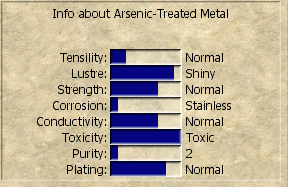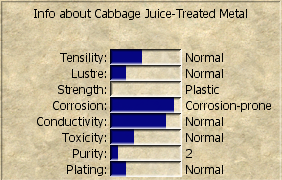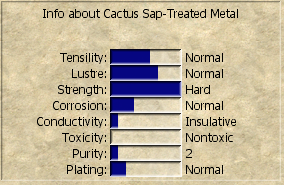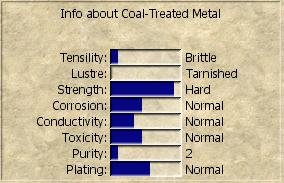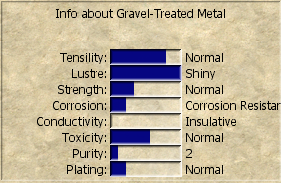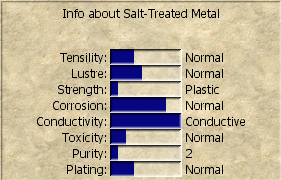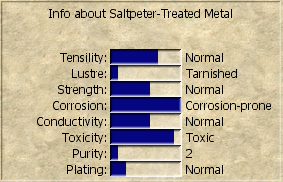The Wiki for Tale 7 is in read-only mode and is available for archival and reference purposes only. Please visit the current Tale 11 Wiki in the meantime.
If you have any issues with this Wiki, please post in #wiki-editing on Discord or contact Brad in-game.
Difference between revisions of "Chemical Bath"
m |
|||
| (7 intermediate revisions by 3 users not shown) | |||
| Line 31: | Line 31: | ||
Can treat up to 100 [[metal]] at a time. | Can treat up to 100 [[metal]] at a time. | ||
| + | |||
| + | == Metal Salt Contamination == | ||
| + | |||
| + | When you use [[Salts of Metal]] to plate a metal, you contaminate your [[acid]] (note that you do not contaminate your acid if you use [[Salts of Metal]] to increase purity; presumably all the salts are deposited on the work piece in that case). If your acid is contaminated with one kind of metal, it prevents you from plating with a different kind. There are two solutions for this problem. One option is to have multiple Chemical Baths, one for each kind of plating you need to do (expensive), OR you can very easily clean up your acid after you plate a batch of metal (cheap). Note: do the cleanup right after the treatment as the key is knowing how many seconds of treatment was done. | ||
| + | |||
| + | * Use 1 db of a different metal and treat it with the same number of seconds as the original treatment with any salt other than the original salt and other than a salt of the metal that you are using to clean the acid. | ||
| + | * After the treatment, the tank should be salt neutral and should not be listed as having any salt in it. | ||
| + | * Remove the 1 db of metal and you should now have a "Salt-free" tank. | ||
| + | |||
| + | For example, your plating treatment was 20 seconds of Salts of Gold. To clean the acid, add 1 db of any metal other than gold, such as copper. Treat the copper with 20 seconds of any salt that isn't gold or copper, such as Salts of Iron. | ||
| + | |||
| + | == Info == | ||
| + | |||
| + | [[File:1,Arsenic.png]] | ||
| + | [[File:1,Cabbage_Juice.png]] | ||
| + | [[File:1,Cactus_Sap.png]] | ||
| + | [[File:1,Coal.png]] | ||
| + | |||
| + | [[File:1,Gravel.png]] | ||
| + | [[File:1,Lime.png]] | ||
| + | [[File:1,Potash.png]] | ||
| + | [[File:1,Salt.png]] | ||
| + | |||
| + | [[File:1,Saltpeter.png]] | ||
| + | [[File:1,Sulfur.png]] | ||
| + | |||
== Reaction Table == | == Reaction Table == | ||
| Line 57: | Line 83: | ||
|- | |- | ||
| Sulfur|| 0||24||16||48||64||56||8||16 | | Sulfur|| 0||24||16||48||64||56||8||16 | ||
| − | | | + | |- |
|} | |} | ||
| − | |||
== Starting values == | == Starting values == | ||
| Line 114: | Line 139: | ||
|- | |- | ||
|Zinc||25||22||40||29||22||29||54||4 | |Zinc||25||22||40||29||22||29||54||4 | ||
| − | | | + | |- |
|} | |} | ||
Latest revision as of 23:55, 16 September 2016
| English | Deutsch | français | magyar | Türkçe |

| |
|---|---|
| Size | 16x30 |
| Where | Compound |
Overview
A chemical bath is used to treat metal.
Source
This building becomes available after you have learned the Basic Metal Treatment tech.
Cost
- 300 Hard Rotproof Fireproof Treated Boards
- 2 Distillation Coil, 7500+ Quality
- 20 Fine Glass Pipe
- 200 Nails
- 40 Bolts
- 80 Washer
- 20 Steel Sheeting
- 20 Iron Bars
- 100 Canvas
- 10 Tar
- 50 Copper Pipe
- 2 Thermometer
Built in a Compound. Uses 16x30 cells.
Use
The bath must be filled with 100 Acid before it can be used. Most folks would consider making 100 Acid non-trivial. So, you don't want to lose it. The menu choice "Empty the Bath" will dump the Acid, and it will be lost. You could then take whatever metal is in the bath, but you'll need to refill the bath with Acid before you can make a new batch.
Preferably, though, you have Tongs. If you do, after treating your metal, use the menu choice "Take Everything". That will preserve the Acid and put the treated metal in your inventory.
Can treat up to 100 metal at a time.
Metal Salt Contamination
When you use Salts of Metal to plate a metal, you contaminate your acid (note that you do not contaminate your acid if you use Salts of Metal to increase purity; presumably all the salts are deposited on the work piece in that case). If your acid is contaminated with one kind of metal, it prevents you from plating with a different kind. There are two solutions for this problem. One option is to have multiple Chemical Baths, one for each kind of plating you need to do (expensive), OR you can very easily clean up your acid after you plate a batch of metal (cheap). Note: do the cleanup right after the treatment as the key is knowing how many seconds of treatment was done.
- Use 1 db of a different metal and treat it with the same number of seconds as the original treatment with any salt other than the original salt and other than a salt of the metal that you are using to clean the acid.
- After the treatment, the tank should be salt neutral and should not be listed as having any salt in it.
- Remove the 1 db of metal and you should now have a "Salt-free" tank.
For example, your plating treatment was 20 seconds of Salts of Gold. To clean the acid, add 1 db of any metal other than gold, such as copper. Treat the copper with 20 seconds of any salt that isn't gold or copper, such as Salts of Iron.
Info
Reaction Table
| Treatment | Tensility | Lustre | Strength | Corrosion | Conductivity | Toxicity | Purity | Plating |
|---|---|---|---|---|---|---|---|---|
| Arsenic | 16 | 64 | 48 | 8 | 48 | 72 | 8 | 56 |
| Cabbage Juice | 32 | 16 | 0 | 64 | 56 | 24 | 8 | 16 |
| Cactus Sap | 40 | 48 | 72 | 24 | 8 | 0 | 8 | 16 |
| Coal | 8 | 0 | 64 | 32 | 24 | 32 | 8 | 40 |
| Gravel | 56 | 72 | 24 | 16 | 0 | 40 | 8 | 16 |
| Lime | 72 | 40 | 56 | 40 | 16 | 8 | 8 | 16 |
| Potash | 64 | 56 | 32 | 0 | 32 | 48 | 8 | 16 |
| Salt | 24 | 32 | 8 | 56 | 72 | 16 | 8 | 24 |
| Saltpeter | 48 | 8 | 40 | 72 | 40 | 64 | 8 | 16 |
| Sulfur | 0 | 24 | 16 | 48 | 64 | 56 | 8 | 16 |
Starting values
| Treatment | Tensility | Lustre | Strength | Corrosion | Conductivity | Toxicity | Purity | Plating |
|---|---|---|---|---|---|---|---|---|
| Aluminum | 22 | 38 | 38 | 23 | 30 | 31 | 54 | 4 |
| Antimony | 20 | 43 | 37 | 36 | 14 | 29 | 54 | 4 |
| Brass | 25 | 43 | 31 | 43 | 31 | 29 | 54 | 4 |
| Bronze | 25 | 40 | 35 | 43 | 31 | 29 | 54 | 4 |
| Copper | 28 | 43 | 44 | 58 | 32 | 36 | 54 | 4 |
| Gold | 22 | 54 | 51 | 36 | 30 | 29 | 54 | 4 |
| Iron | 36 | 29 | 41 | 36 | 18 | 29 | 54 | 4 |
| Lead | 16 | 14 | 24 | 36 | 12 | 50 | 54 | 4 |
| Lithium | 14 | 29 | 29 | 43 | 37 | 29 | 54 | 4 |
| Magnesium | 19 | 29 | 37 | 22 | 24 | 36 | 54 | 4 |
| Metal Blue | 37 | 43 | 52 | 61 | 59 | 29 | 54 | 4 |
| Moon Steel | 21 | 29 | 34 | 36 | 25 | 29 | 54 | 4 |
| Pewter | 19 | 36 | 29 | 36 | 13 | 43 | 54 | 4 |
| Platinum | 33 | 56 | 40 | 37 | 19 | 30 | 54 | 4 |
| Silver | 23 | 47 | 36 | 50 | 32 | 29 | 54 | 4 |
| Steel | 35 | 43 | 45 | 36 | 20 | 29 | 54 | 4 |
| Strontium | 16 | 36 | 30 | 36 | 16 | 36 | 54 | 4 |
| Sun Steel | 19 | 60 | 40 | 37 | 28 | 30 | 54 | 4 |
| Thoth's Metal | 46 | 36 | 53 | 58 | 15 | 43 | 54 | 4 |
| Tin | 19 | 36 | 26 | 36 | 17 | 29 | 54 | 4 |
| Titanium | 26 | 43 | 43 | 36 | 61 | 29 | 54 | 4 |
| Tungsten | 57 | 22 | 52 | 47 | 23 | 36 | 54 | 4 |
| Water Metal | 16 | 47 | 30 | 36 | 36 | 29 | 54 | 4 |
| Zinc | 25 | 22 | 40 | 29 | 22 | 29 | 54 | 4 |
